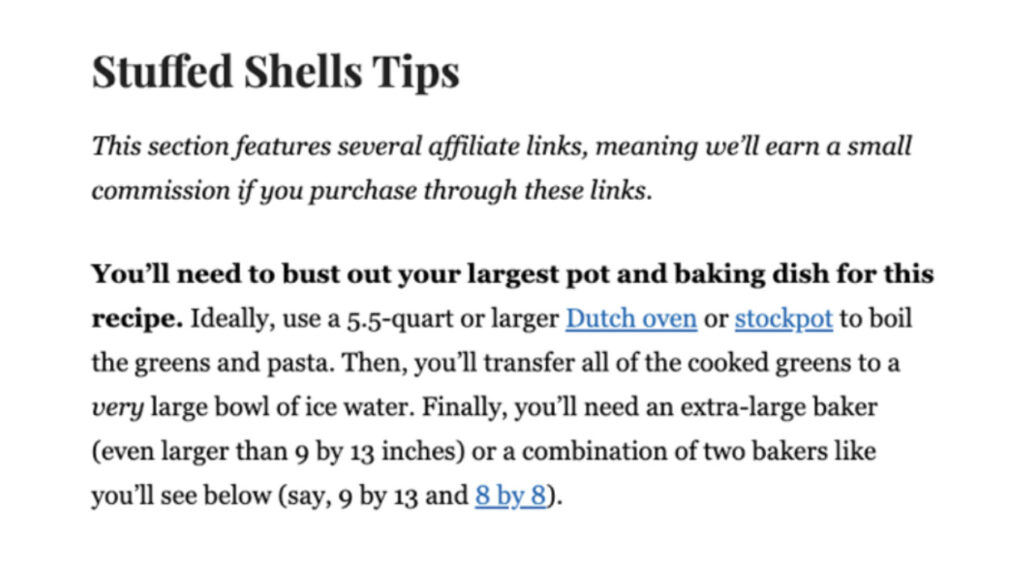An affiliate disclosure, or disclaimer, states that certain links on a platform are affiliate links, informing users of your website that you are compensated for promoting specific products.
Affiliate links refer users to other companies’ products or services. When someone buys something through an affiliate link, the content owner typically receives a commission from the other company.
But why do you need one? And what should be included in a good disclosure? Dive right in to find out!
Table of Contents
Why Do You Need An Affiliate Disclosure?
The first and foremost reason you need an affiliate disclosure is that the FTC mandates it. Their guideline states you must include one when compensated for reviewing or writing about products or services.
Those reviews or other content might influence a consumer’s decisions or purchases. It makes sense to inform your readers about any commissions you might receive for them purchasing one of your links.
Including an affiliate disclosure is a matter of best business practice. It helps you build an open and transparent relationship with your readers. It helps them make informed decisions based—at least partly—on your great content. Helping your readers should be the main target behind any affiliate website.
What Could Go Wrong When You Fail To Add An Affiliate Disclosure?
You might wonder if adding a disclosure is really that important. If that’s the case, the following example might be eye-opening.
A prime example of what can go wrong without a proper affiliate disclosure is between now-defunct online retailer LulaRoe and blogger Christina Hinks. After reviewing several blogs, it was found that Hinks failed to disclose she was an affiliate for over 100 posts.
LulaRoe was later sued for $49 million by disgruntled consultants because they felt the company tricked people into joining their group by saying they could earn a six-figure salary if they joined the team and started selling their clothes. LulaRoe has been pegged with accusations of running a pyramid scheme.
In this case, consumers read Hinks’ blogs and decided they wanted to join the LulaRoe team, thus falling for the alleged pyramid scheme. If LulaRoe is compensating Hinks, it’s unfair for her to recommend their products directly. Moreover, LulaRoe’s discredited state has also harmed Hinks’ credibility.
This example illustrates the importance of being open and transparent to your readers and always knowing what you endorse.
Would Hinks have made the same choices if she had known about the pyramid scheme? Or did she know but not care in pursuit of making a few bucks?
We’ll never know, but a disclosure about her getting compensated for promoting LulaRoe might have helped to soften the blow to her credibility.
The Importance Of Being Trusted By Your Readers
No one wants to be seen as an affiliate marketer trying to deceive their readers by posting overly positive reviews or saying, “This product was sent to me in exchange for my honest opinion.” In the long run, content genuinely helping consumers make better decisions will always win out over deceitful content.
A nice bonus is that you, as the one writing the content, might sleep a lot better knowing that your commissions weren’t collected at the expense of your readers.
So, what should be included in your disclosure?
The Federal Trade Commission has recently revised its guidelines for affiliate disclosures. This is a list of five things you need to know about them:
Don’t Just Link to Your Disclosure: Simply putting a link to your disclosure somewhere like the top, bottom, or side of your page isn’t enough. The FTC wants your disclosure to be more visible than that.
Place the Disclosure Up Front: Make sure to show your disclosure before any affiliate links. It’s important to have it at the start of your content or where your readers are most likely to first engage with your page. Putting it at the end won’t cut it.
Make Your Disclosure Stand Out: Hiding your disclosure with small text, colors that blend into the background, or any other sneaky methods won’t work. The FTC says your disclosure needs to be easy to see and understand.
Be Clear About Affiliations: Just tagging something as (Affiliate) or #Affiliate might not be enough, especially if your readers aren’t familiar with what affiliate marketing is. Using #ad is clearer because most people understand what an ad is.
No Extra Steps to See the Disclosure: Your readers should be able to understand your relationship with the brands you’re promoting directly from your disclosure without having to click on anything else for more information. If they need to click on a link to see your disclosure, you’re not meeting the FTC’s standards.
How To Add An Affiliate Disclosure To Your Blog Or Website?
Now that you understand the importance of affiliate disclosures, it’s time to get to the technical part. There are a few different ways to add them to your website.
Although affiliate disclosures should appear on every page that includes affiliate links and content, it’s good practice to include a dedicated affiliate disclosure page on your website. You can then link to this page from prominent places on your site, such as:
- Header
- Footer
- Sidebar
- Terms and conditions
- Privacy policy
Please note that this does not replace displaying disclosures close to affiliate links or content. It is an excellent way to offer your readers additional information on the affiliate partnerships you might endorse.

To ensure compliance and transparency, affiliates should craft disclosures that are easy to find, straightforward, and offer clear explanations of their affiliate relationships. They should also consult with experts on this field and make sure they comply with all the current regulations and guidelines for their specific target country.
Affiliate Link Disclosure Examples
Here are some examples of texts that you might use as the basis for formulating your very own affiliate disclosures.
I may receive a small commission from products/services bought through this site.
Another example of placing a disclosure might look something like this:
As you can see, the disclosure, including affiliate links, is placed at the beginning of the section, letting readers know what they’re in for right from the start. This way, readers know what kind of links they’re clicking on.
Many affiliate networks already have widgets you can add to your site, so you do not need to create one yourself.
Amazon Affiliate Disclosure Example
Amazon and the US Federal Trade Commission (FTC) have made it plain that associates must declare their participation in the program to their audience since product marketing by Amazon Associates (also known as Amazon affiliates) constitutes a type of advertising.
To help you avoid being kicked out of the affiliate program or, even worse, having your earnings taken by law authorities, we’ve provided the Amazon and FTC disclosures you need below:
Amazon affiliate disclosure – Example 1: “As an Amazon Associate, I earn from qualifying purchases.”
Amazon affiliate disclosure – Example 2: “[Your name or the name of your website] is a member of the Amazon Services LLC Associates Program, an affiliate marketing scheme created to allow websites to make money through advertisements and links to Amazon.com.”
Affiliate Disclosure From FTC
The FTC, unlike Amazon, does not mandate that your affiliate disclosure adheres to a specific format. Instead, the commission assesses how well-understood your disclosure is by the average user.
On your website or blog, we advise using the FTC affiliate disclosure statement below:
FTC affiliate disclosure example: “I get commissions for purchases made through links in this post.”
Affiliate Disclosures Make Your Website Compliant And User-Friendly
As we have seen in this article, when hosting an affiliate website or promoting affiliate links, you must use affiliate disclosures to inform your readers.
You might impact people’s decisions and the products they buy. It’s only natural to let them know what informs those decisions.
Even if it wasn’t required by law, it would be good business practice to be transparent to your readers. You’re making an impact on their lives, so the least you could do is let them know how that impact came to be and express your interest in it.





